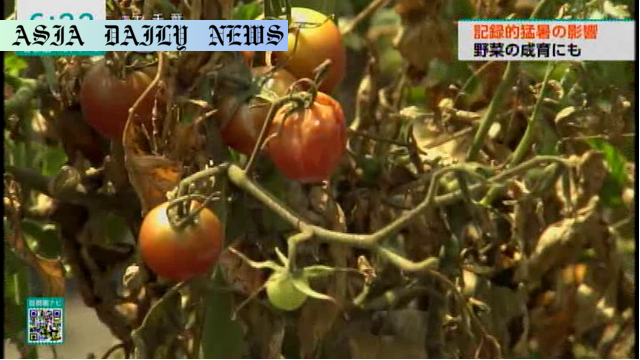Heatwave: Persistent heat in Japan is disrupting vegetable crops, causing farmers to lose up to 30% of their harvest.
Heatwave intensifies in Japan, severely affecting vegetable production.
Farmers face water shortages and crop deterioration amid record heat.
Crops like cucumbers, tomatoes, and eggplants are particularly vulnerable.

Heatwave and Its Impact on Japan’s Agriculture Sector
The current record heat in Japan is becoming a major issue for the country’s agricultural sector, leaving farmers in distress and struggling with substantial losses. This relentless heat, combined with a lack of rain, has created conditions that severely impair vegetable farming. In Tachikawa City, western Tokyo, Koyama Misao, a local farmer who grows over 160 varieties of vegetables, has been directly affected by these challenging weather patterns. The soil on his farm dries up too quickly, making it impossible for vegetables like cucumbers, cherry tomatoes, and eggplants to thrive.
The extreme heat is wreaking havoc on crops, with cucumbers wilting before they can even be harvested, and cherry tomatoes showing visible damage. Yellow cherry tomatoes, somewhat more heat-tolerant, have started developing brown leaves, while parts of their fruit turn black. Red cherry tomatoes, in turn, burst under the heat and become overly soft. Eggplants suffer in different ways as their skin hardens and loses its attractive shine, rendering them unfit for market standards.
Economic Losses and Farmer Adaptations
Koyama reports that he has been forced to discard 20–30% of his vegetable yield, throwing away nearly 50 to 60 kilograms of crops just in the last month. The resulting financial impact is significant, and farmers like Koyama are struggling to adjust to the cumulative losses. While some edible but aesthetically unappealing produce has been sold at discounted rates to local buyers, Koyama has also generously donated excess vegetables to facilities that provide free meals to children. Despite these innovative approaches, the looming threat of losing his entire crop continues to disrupt his peace and sleep.
Throughout Japan, similar stories are unfolding as prolonged extreme temperatures diminish crop viability. Without significant advancements in heat-resistant crop technology or urgent climate control measures, the agricultural sector faces long-term risks that could extend beyond the summer season.
Urgency for Climate Resilience and Agricultural Innovation
The challenges faced by farmers like Koyama underscore the urgent need for adaptive strategies in agriculture. While promoting local consumption of farm produce has helped move surplus crops, this alone does not solve the deepening crisis. Investments in better irrigation systems, adoption of high-tech farming equipment, and research into heat-resistant plant varieties will play an essential role in safeguarding crop production against intensifying global temperatures.
The situation in Japan serves as an eye-opening case study of how climate-induced disruptions can ripple outward, affecting economic stability, food prices, and community health. Integrated government initiatives, private solutions, and grassroots cooperation will be essential in creating a sustainable pathway forward for farmers and food supply chains alike.



Commentary
The Growing Threat of Climate Change on Agriculture
The recent news about Japan’s enduring heatwave and its devastating effects on agriculture highlights the troubling realities of climate change. Year after year, unusual weather patterns are becoming a norm rather than an exception, and farmers globally are feeling the brunt of these shifts. Koyama Misao’s story in particular paints a stark picture of how delicate and susceptible our food systems are to environmental disruptions. These conditions not only damage crops but also add significant emotional and financial strain on farmers, who often work tirelessly to sustain their livelihoods and provide for global communities.
The Financial and Human Cost of Crop Loss
It is staggering to consider how much food is wasted under these harsh climate conditions. In Koyama’s case, 50 to 60 kilograms of produce had to be discarded in just one month. Beyond the monetary losses, the labor and care invested in growing these crops highlight the persistent sacrifices farmers make daily. On the flip side, it’s uplifting to hear how individuals like Koyama find ways to turn adversity into something meaningful by donating the substandard vegetables to local organizations aiding children. This small silver lining, however, should not detract from the larger systemic challenges that need addressing.
Urgent Need for Policy and Climate Action
The conditions in Japan serve as a sobering reminder of the importance of addressing climate change head-on, particularly as it pertains to agriculture. Governments and organizations must accelerate the development of climate-resilient crops and infrastructure. At the same time, consumers also have a role to play, whether by supporting local farmers, reducing waste, or pressing for climate action. Without a unified effort, farmers will continue to shoulder the burden, jeopardizing not only their livelihoods but also food security across the globe.